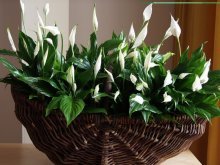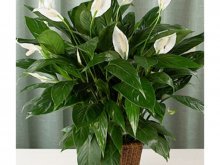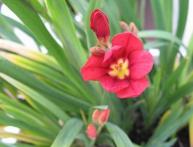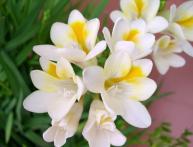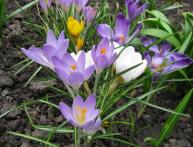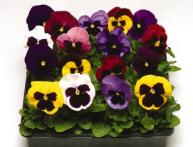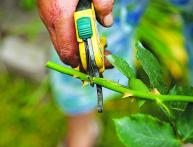Spathiphyllum flower or “female happiness”: how to care for it indoors?
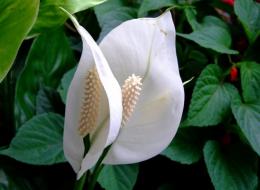
The unpretentious spathiphyllum is especially popular among gardeners. This is explained by its absolute lack of demands on the level of illumination. A plant like spathiphyllum can grow successfully in almost any room.
Content:
- Botanical description of spathiphyllum
- Growing conditions and care
- Basic methods of reproduction
- Pests and diseases
Botanical description of spathiphyllum
Spathiphyllum is a typical representative of the large Araceae family. It is a terrestrial tropical evergreen plant. Naturally distributed in Central and South America, as well as on a number of tropical islands. There it can be found in places with high humidity, as well as along the banks of rivers and streams.
Spathiphyllum is characterized by a very short rhizome and oval or lanceolate entire leaves. It has no stem. The leaves are located on elongated petioles.
Inflorescence spathiphyllum - This is a cob with a white cover. After flowering it begins to gradually turn green. The name spathiphyllum comes from two Greek words spathe - bedspread and phyllon - leaf. Popular beliefs endow this plant with magical powers. According to them, if there is spathiphyllum in the house, then a lonely woman will definitely find a life partner.
Growing conditions and care
Spathiphyllum comes from tropical areas, so for successful growth and development it requires temperatures above +18°C. Also, this plant does not tolerate drafts at all.
Lighting and watering
When choosing a place to place a plant, preference should be given to north-oriented windows. Direct sunlight is harmful to it. Also, this culture can grow quite successfully and even bloom even in the back of a room or under artificial light.
Like all tropical plants, spathiphyllum needs abundant watering in the summer. It also benefits from periodic spraying with warm, settled water. The soil The pot should always be in a slightly damp state, but it is very important to avoid flooding. Excess moisture is detrimental to spathiphyllum.
Soil, fertilizing and replanting
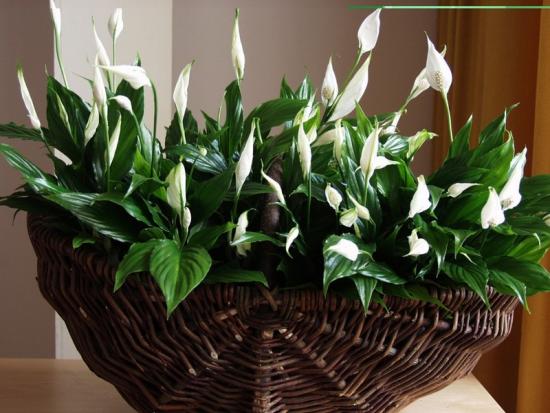
To grow this crop, a suitable soil mixture is made up of 2 parts turf soil, 1 part humus, 1 part peat and 1 part river sand. If it is not possible to prepare the substrate yourself, you can use a special soil for growing aroid plants.
In order for spathiphyllum to bloom profusely, it must be systematically fed. To do this, you can use any universal fertilizer for flowering indoor plants. It should be diluted according to the attached instructions. In spring and summer, fertilizers are applied once every two weeks. By autumn, feeding is stopped and resumed only with the arrival of spring.
Spathiphyllum is characterized by rather intensive growth, so it needs annual replanting. This is best done by transferring it into a larger pot.It is best to plan replanting work in the spring. The new pot should be slightly larger than the old one.
Basic methods of reproduction
Reproduce Spathiphyllum can be grown either vegetatively or by seeds. The seed propagation method is quite labor-intensive, and it is difficult to obtain the seeds of this plant, so it is practically not used. Of the vegetative methods of propagation, the most widespread is dividing the bush.
It is best to carry it out in the spring during the planned annual transplant. To do this, the overgrown plant is carefully divided into several parts. The first time after planting, it is recommended to spray them as often as possible. Further care for them is no different from caring for adult plants.
Video about proper care of spathiphyllum:
Spathifullum also propagates quite successfully from apical cuttings. This method allows you to propagate the plant without damaging the root system. For this, cuttings with small root rudiments are cut at the base of the plant using a sharp knife. Then they are planted in a loose nutrient substrate and covered with a jar or plastic bag. The creation of a greenhouse effect contributes to their accelerated rooting.
Pests and diseases
Like any other plant, spathiphyllum can be attacked by harmful insects. Most often you can find it pests, which will be discussed further in the article.
Thrips. Small sucking insects that can cause significant harm to the plant, and if left untreated, even lead to its death. The main sign of their appearance is dry discolored areas on the leaves. Also, upon closer inspection, you can see the insects themselves.
To destroy these pests, various insecticidal preparations are used. For example, you can use “Aktara”, “Commander” or “Mospilan”. After two weeks, the treatment must be repeated.
Mealybug. Also belongs to the group of sucking pests. Its characteristic feature is a white powdery coating, which is why this pest got its name. To combat it, contact insecticides are used. “Aktara”, “Tanrek”, “Konfidor” show good results.
If the pest population is small, non-chemical control methods can be used. For example, spraying a plant with tobacco infusion or a solution of green soap is very effective.
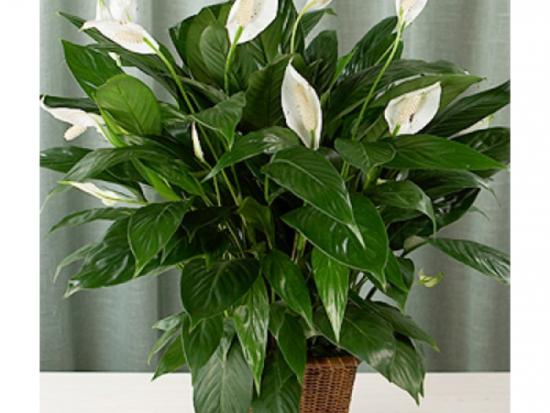
Spider mite. A dangerous and difficult to destroy sucking pest. Its characteristic feature is a sticky cobweb-like coating on the leaves. Spider mites most often appear when air humidity levels are too low.
To combat it, you need to use only special insecto-acaricidal preparations. Simple insecticides are not suitable for its destruction. Of the most effective means of destruction spider mite It is worth noting "Aktellik" and "Fitoverm".
Growing a flowering specimen of spathiphyllum in your home is quite simple. This plant does not have increased requirements for growing conditions. This crop is ideal for decorating almost any room, and even a completely inexperienced gardener can easily cope with its cultivation.

